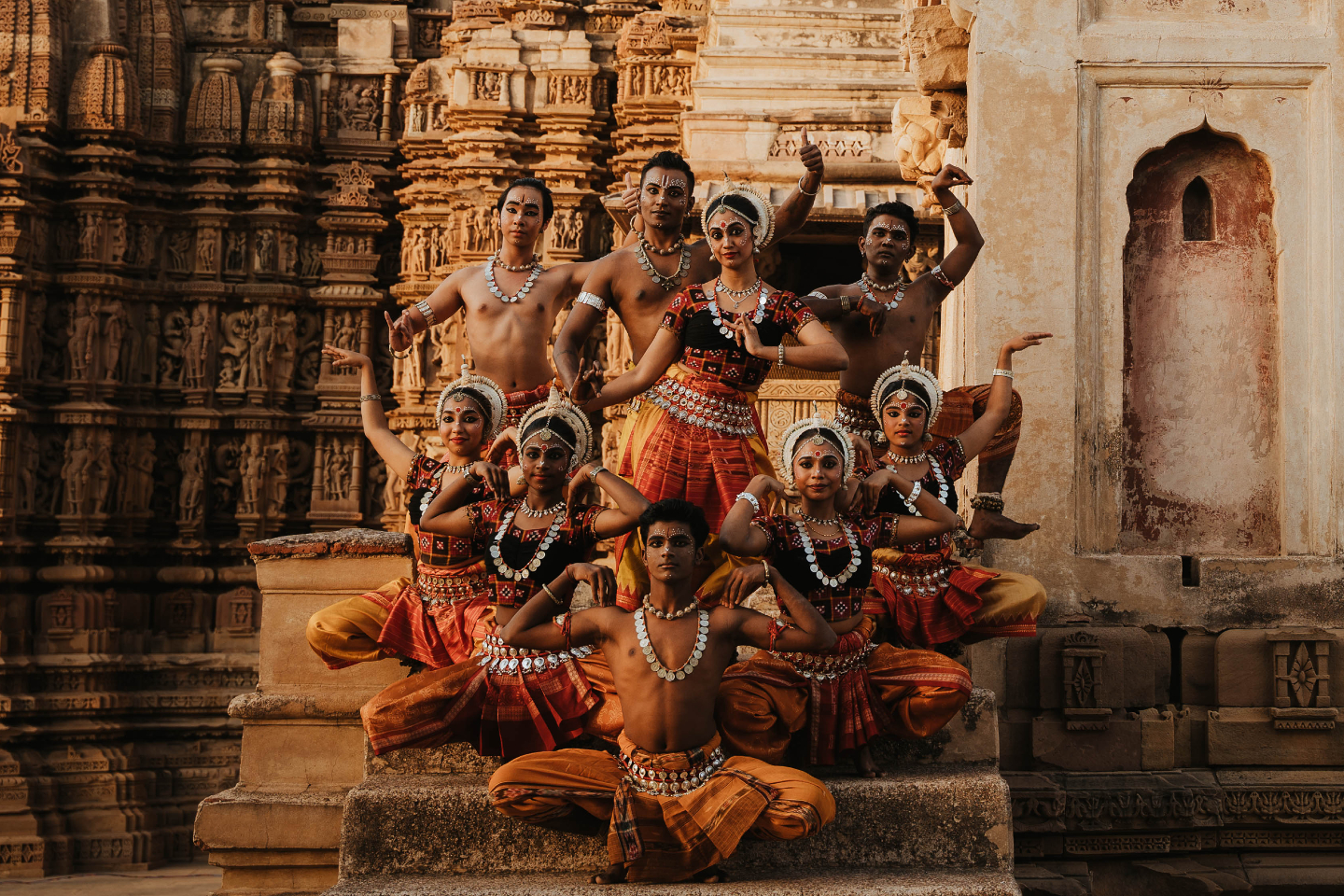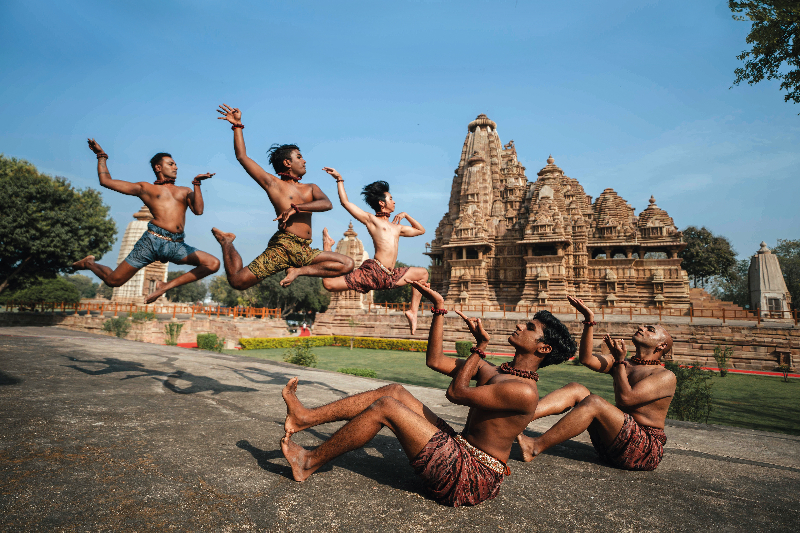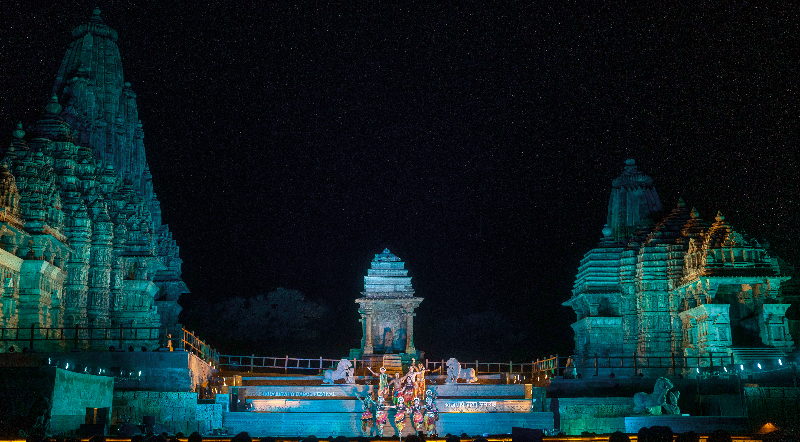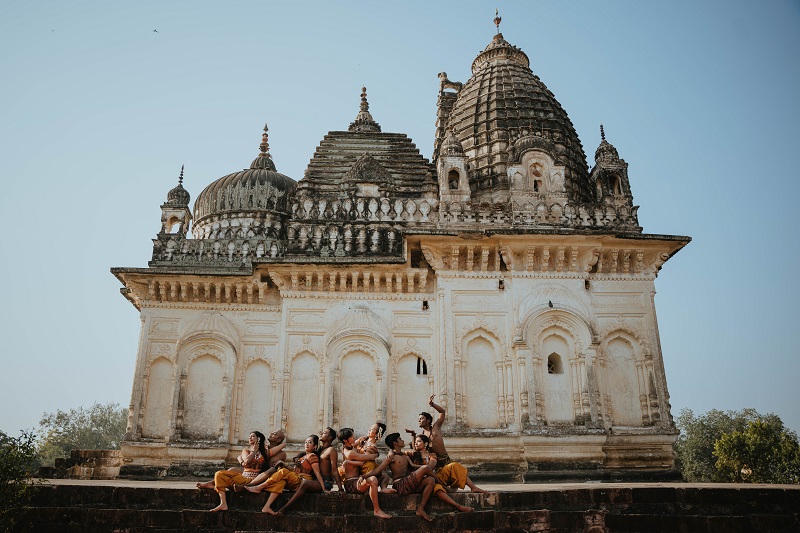
It is perhaps only in India that dancers perform for the gods in a setting that is literally created for the gods themselves (Photo: S Magendran)
Mention Khajuraho and it’s a sure bet references to its famous erotic sculptures or even the Kama Sutra will crop up. But, beyond the Unesco World Heritage site’s risqué carvings — which, incidentally, account for only 10% or less of the sprawling temple complex’s total adornment — the city in Chhatarpur district of the central Indian state of Madhya Pradesh offers so much more for the modern globetrotter.
Of Kings + Culture
A culturally rich and historic destination, Khajuraho is cradled by the Vindhya mountain range, which is of great significance in local mythology and history as it is believed to be the traditional boundary between north and south India. It has a plethora of natural attractions, including wonders like the Raneh Falls Canyon and Panna Tiger Reserve. However, if you consider yourself a rasika, an enlightened being in possession of rasa, a Sanskrit term referenced in the Upanishads that speak of essence, self-consciousness and quintessence, there is nowhere else in the world to be every February than Khajuraho.
sm200599.jpg

Ever since it was founded in the ninth century by the Chandela kings, Khajuraho steadily added to its tally of temples, all of which became more imposing in size as well as stature. Today, architectural enthusiasts come from all corners of the globe to marvel at the stunning examples of classic Nagara-style architecture, identifiable by multiple towers (as opposed to single-towered Dravidian ones) called shikhara, which are further crowned by amaleks (horizontal fluted discs) and kalash (vases). It is said the plural vertical thrust of the shikhara is designed as a symbol of power. At the Chandela dynasty’s zenith, Khajuraho was believed to house at least 85 magnificent places of worship. Today, only about a quarter of the monuments remain.
Established 49 years ago, the Khajuraho Dance Festival, held over a full week at the end of every February, is considered to be the preeminent celebration of classical Indian dance. Beyond the roll-call of the most esteemed exponents of Indian classical dance in the world, the setting also deserves special applause. Khajuraho’s temples are best divided into three broad categories: the Eastern, Southern and Western groups. The last group — the largest, most imposing and most important — is the site of the dance festival’s main performances itself.
sm100204.jpg

Dancers have the unique privilege of performing before the Laxmana Temple, which dates back to AD930-950, while the largest and loftiest temple, the Kandariya Mahadev (1025-1050), forms what could be the most jaw-dropping backdrop, sharing a platform with the neighbouring early 11th-century Devi Jagadambi temple. In the course of a single dance, both performer and audience are transported back to the era when the Chandelas ruled over the Bundelkhand region, which was then known as Jejakabhukti, and when things were so glorious that local legend states Khajuraho got its name from two solid gold date palm trees (the Sanskrit name for date palms is kharjura) flanking the temple gates. Even the eminent 14th-century Moroccan scholar and explorer Ibn Battuta wrote about his time here in his memoirs, referring to the city as Kajarra.
Khajuraho’s golden allure, however, diminished with time, following numerous Mughal invasions between the 13th and 18th centuries, and particularly when Sikandar Lodi of the Delhi Sultanate began his protracted campaign of temple destruction. Thankfully, Khajuraho’s remoteness saved the majority of the sacred structures from widespread desecration by Muslim invaders but time and neglect soon became another enemy to reckon with, as jungle and vegetation slowly overgrew the temples. It was only in the 1830s that Khajuraho was rediscovered by British army captain T S Burt, who chanced upon the lost complex of temples while out surveying.
sm200282.jpg

The divine dance
It is perhaps only in India that dancers perform for the gods in a setting that is literally created for the gods themselves. Few other venues, not even the grand dance festival held in Konark, Odisha, bring dancers and rasikas in such close proximity to the ancient monuments. Applause must also be given to the culturally proactive government which generously opens the temple grounds at dusk so everyone, young and old, local or foreign, may immerse themselves night after night in an intoxicating cocktail of world-class dance, history and culture completely gratis.
Of late, contemporary dance has been included in the Khajuraho Dance Festival’s lineup, albeit as a fringe event and not part of the primary repertoires. The raison d’être of the festival is, of course, to celebrate the great classical dance forms of India whose roots are firmly embedded in the Natya Shastra, the 200 BCE Sanskrit treatise on the performing arts attributed to the sage Bharata Muni.
The Sangeet Natak Akademi, India’s national performing arts academy, presently recognises eight main dance forms: Bharatanatyam, Kathak, Kuchipudi, Satriya, Manipuri, Kathakali, Mohiniyattam and Odissi. Over the course of seven nights, guests may expect to see three to four performances each time, usually featuring any of the aforementioned eight styles. But beyond dance, workshops, film screenings, talks on arts and heritage and other cultural events, the hugely inclusive Khajuraho Dance Festival also encompassed other activities, ensuring something for everyone.
sm100145.jpg

This year’s mela, for example, comprised Hunnar Haat, an arts and crafts village in the style of an open-air bazaar. Local children enjoyed going around the festival grounds on Segways while foreign guests feasted on the array of Bundeli cuisine at the various stalls that sprouted up pre-performance every evening. Craft demonstrations, from weaving to pottery, were conducted and the local tourism council even offered a variety of adventure tourism options around Khajuraho, including camping in the Bear Valley Camp, walking with members of the local Pardi tribe at Panna National Park or water-rafting down the Ken and Chambal Rivers.
Glancing around, it is hard to imagine how Khajuraho could have ever been forgotten. But to those willing to look beyond the sensationalised erotica, Khajuraho is perhaps the perfect microcosm of what it means to live a beautiful existence — where divinity is part of your everyday and where the simple, natural acts of love and life are not just elevated to an art form but immortalised forever for future generations to learn from and treasure. Life, as we know, always goes on. May Khajuraho’s legacy endure likewise.
'Jaya Ram' will be staged at the Shantanand Auditorium of the Temple of Fine Arts from March 23-25. Purchase tickets here.
This article first appeared on Mar 20, 2023 in The Edge Malaysia.


